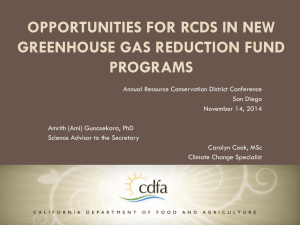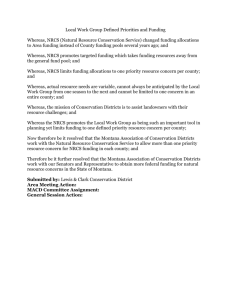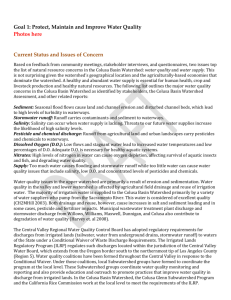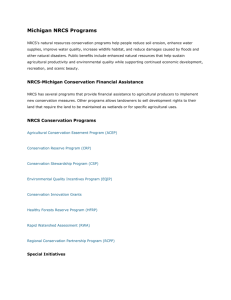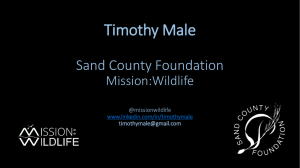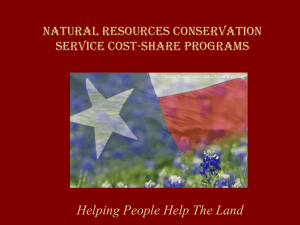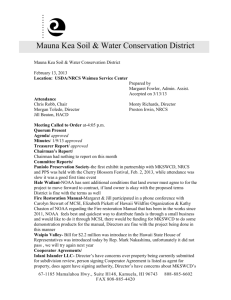Goal #8: Address unnknown future affects of climate change
advertisement
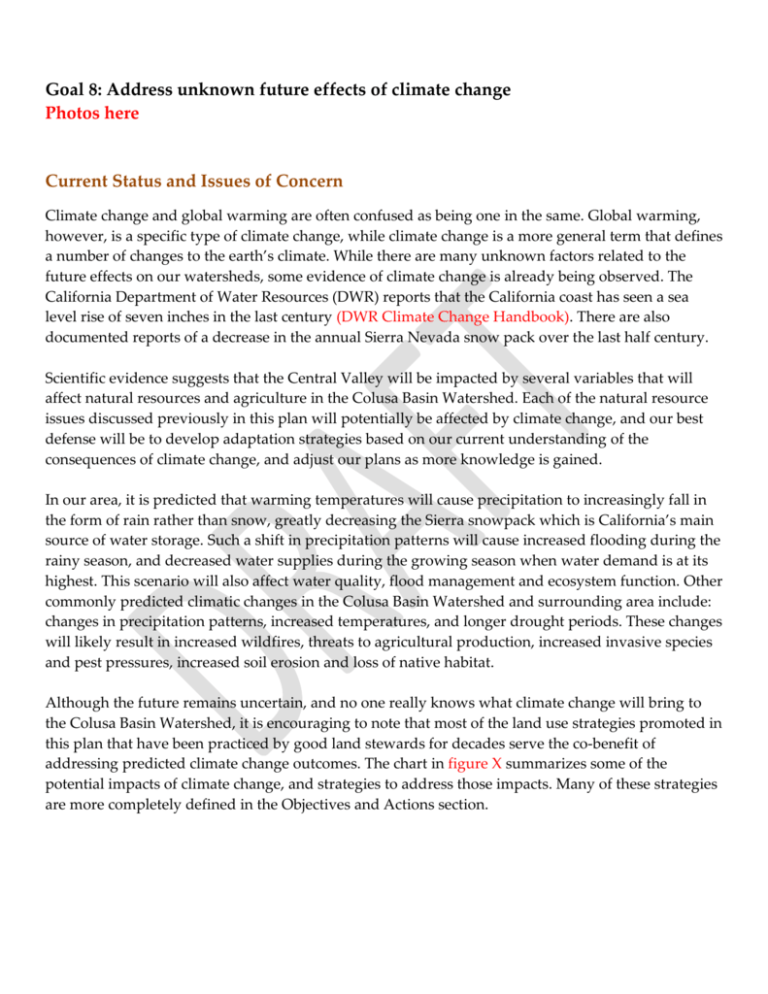
Goal 8: Address unknown future effects of climate change Photos here Current Status and Issues of Concern Climate change and global warming are often confused as being one in the same. Global warming, however, is a specific type of climate change, while climate change is a more general term that defines a number of changes to the earth’s climate. While there are many unknown factors related to the future effects on our watersheds, some evidence of climate change is already being observed. The California Department of Water Resources (DWR) reports that the California coast has seen a sea level rise of seven inches in the last century (DWR Climate Change Handbook). There are also documented reports of a decrease in the annual Sierra Nevada snow pack over the last half century. Scientific evidence suggests that the Central Valley will be impacted by several variables that will affect natural resources and agriculture in the Colusa Basin Watershed. Each of the natural resource issues discussed previously in this plan will potentially be affected by climate change, and our best defense will be to develop adaptation strategies based on our current understanding of the consequences of climate change, and adjust our plans as more knowledge is gained. In our area, it is predicted that warming temperatures will cause precipitation to increasingly fall in the form of rain rather than snow, greatly decreasing the Sierra snowpack which is California’s main source of water storage. Such a shift in precipitation patterns will cause increased flooding during the rainy season, and decreased water supplies during the growing season when water demand is at its highest. This scenario will also affect water quality, flood management and ecosystem function. Other commonly predicted climatic changes in the Colusa Basin Watershed and surrounding area include: changes in precipitation patterns, increased temperatures, and longer drought periods. These changes will likely result in increased wildfires, threats to agricultural production, increased invasive species and pest pressures, increased soil erosion and loss of native habitat. Although the future remains uncertain, and no one really knows what climate change will bring to the Colusa Basin Watershed, it is encouraging to note that most of the land use strategies promoted in this plan that have been practiced by good land stewards for decades serve the co-benefit of addressing predicted climate change outcomes. The chart in figure X summarizes some of the potential impacts of climate change, and strategies to address those impacts. Many of these strategies are more completely defined in the Objectives and Actions section. Figure X: Impacts and Strategies Related to Climate Change in the Colusa Basin Watershed Climate Change Impacts Strategies to Address Impacts Decreased water supply Spreading basins*; vegetation enhancement for erosion control and (surface & groundwater) groundwater recharge; wetland enhancement; increased soil organic matter; invasive weed control; water conservation; water use efficiency; water storage Decreased water quality Vegetation enhancement for erosion control and groundwater recharge; water conservation Reduced streamflows Water conservation Increased flooding Spreading basins with vegetation enhancement; wetland enhancement; levee protection; water storage Decreased hydropower Water storage Decreased ecosystem function vegetation enhancement for erosion control, habitat and groundwater recharge; spreading basins; wetland enhancement; invasive weed control; water conservation; water use efficiency Agricultural production Adjust cropping patterns; integrated pest management (IPM); water impacts use efficiency; invasive species control Increased wildfire Brush control/fuels reduction Increased invasive plant Early detection and eradication; native vegetation enhancement species Increased pest pressures Crop rotation; IPM Soil erosion Vegetation enhancement; conservation tillage Habitat loss Native vegetation enhancement; habitat restoration; wetland enhancement * a spreading basin is an area, usually adjacent to a stream, where water is allowed to pool during rain events so it can percolate back into the ground. Vegetation enhancement helps facilitate this process as plant roots open up the soil and provide an avenue for water to move into the earth. Considerations Stay up to date with current science and understand the necessity of adaptive management as it relates to climate change issues Recognize, support and promote current land stewardship practices that also provide protections against effects of climate change Promote agricultural and the non-agricultural community’s ability to adapt to changing water supply and availability and to utilize existing resources as efficiently as possible while allowing for a healthy, functioning watershed Objectives and Actions Objective #1: Maintain a collaborative partnership with the research community to stay current on science related to climate change, and disseminate information gained Action Entities involved Attend workshops and conferences related to RCDs current climate change science Build a Climate Change partnership to enhance Climate change science community information exchange; start with pre-existing RCDs climate change organizations and partnerships NRCS Landowners and Land Managers Provide education and outreach to both RCDs agricultural and non-agricultural entities on NRCS assistance methods to address local effects of climate change Objective #2: Enhance biodiversity conservation and ecosystem services to promote sustainable natural ecosystems and human wellbeing Action Entities involved Recognize and promote current land stewardship RCDs practices that will provide the co-benefit of NRCS mitigating effects of climate change Other conservation organizations Landowners and Land Managers Provide and promote natural resource RCDs conservation incentives for private landowners NRCS Department of Fish and Game Other conservation organizations Provide resources for invasive species control RCDs NRCS Weed Management Areas Agricultural Commissioners Take steps to ensure water quality and water RCDs supply issues are addressed NRCS Landowners and Land Managers Water-related Organizations Promote activities that enhance groundwater recharge and storage, including spreading basins, wetland development (where appropriate) and vegetation enhancement Create connected corridors of habitat to facilitate wildlife movement Promote vegetation enhancement including native habitat, native rangeland species, cover crops, etc. Reduce wildfire risks RCDs NRCS IRWM groups RCDs Other conservation organizations Landowners and Land Managers RCDs NRCS Other conservation organizations Landowners and Land Managers RCDs NRCS Objective #3: Support programs that promote carbon sequestration and greenhouse gas (GHG) reduction Action Entities involved Promote no-till and reduced-till practices RCDs NRCS Landowners and Land Managers Promote WHIP and other wetland enhancement RCDs programs NRCS Other conservation groups Promote vegetation enhancement including native RCDs habitat, native rangeland species, cover crops, etc. NRCS Promote and provide resources to increase on-farm RCDs fuel use efficiency & sustainable energy NRCS Resources The following resources are available for information and technical assistance: California Climate and Agricultural Network (CalCAN) www.calclimateag.org California Department of Fish and Game Climate Science and Renewable Energy Branch www.dfg.ca.gov/Climate_and_Energy California Department of Water Resources www.water.ca.gov CalFire www.fire.ca.gov Flex Your Power www.fypower.org Global Green USA www.globalgreen.org National Center for Appropriate Technology www.ncat.org Natural Resources Conservation Service (NRCS) Colusa County 100 Sunrise Blvd., Suite B, Colusa CA 95932 530.458.2931 Glenn County 132 North Enright Avenue, Suite C, Willow, CA 95988 530.934.4601 X3 Yolo County 221 W. Court Street, Woodland, CA 95695 530.662.2037 Pacific Gas and Electric Company www.pge.com Resource Conservation Districts (RCDs) Colusa County 100 Sunrise Blvd., Suite B, Colusa, CA 95932 530.458.2931 X3 www.colusarcd.org Glenn County 132 North Enright Avenue, Suite C, Willow, CA 95988 530.934.4601 X5 www.glenncountyrcd.org Yolo County 221 W. Court Street, Woodland, CA 95695 530.662.2037 www.yolorcd.org
